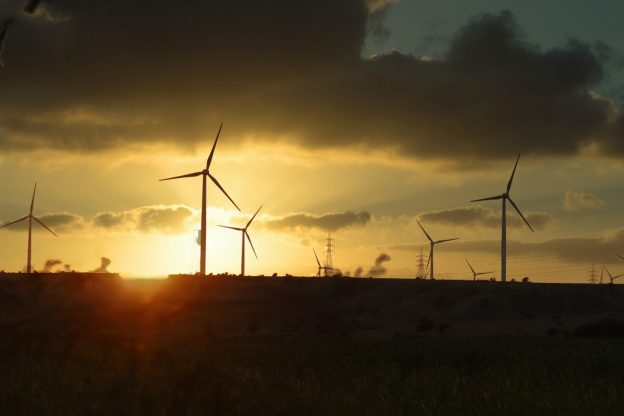For the energy sector, Pakistan passed a federal law establishing the Pakistan Council of Renewable Energy Technologies in 2010 and another law promoting energy efficiency and conservation in 2016.
In terms of an institutional framework, the government established the Alternative and Renewable Energy Board in 2010, empowered to develop national strategies, policies, and plans for the utilization of alternative and renewable energy resources to achieve the targets set by the federal government.
In 2013, the Government of Pakistan issued the National Power Policy that provides an overall direction for energy policy in the country. It identified challenges including a huge supply-demand gap, increasing prices due to dependence on thermal fuel sources, and energy inefficiency; it set a target of reducing the supply-demand gap to zero and reducing transmission and distribution losses from approximately 23–25 % to 16% by 2017. This aim has clearly not been achieved to date, as Pakistan has not reached 100% access to energy across the country.
In 2019, a new policy on alternative and renewable energy was adopted. For the first time, the government set a quantifiable target of 20% contribution from green energy sources including solar, wind, and bagasse (a type of biofuel) by 2025 and 30% by 2030. In December 2020, then–Prime Minister Imran Khan announced at the Climate Ambition Summit that Pakistan would not build new coal plants. However, the challenge was to formalize this intention, and, in fact, several coal plants that were already permitted or under construction have continued to be developed.
The Government of Pakistan also approved a national-level policy on electric vehicles in 2019 with ambitious targets of 30% and 90% share in the sale of passenger vehicles and heavy-duty trucks by 2030 and 2040, respectively.
Recent developments
In February 2021, the Government of Pakistan released the National Electricity Plan that identified three main goals for the power sector – access to affordable energy, energy security, and sustainability. While it did not quantify any goals, the policy stressed diversification of the fuel mix in the country and optimizing energy resource utilization.
In the same year, Pakistan updated and submitted an enhanced NDC that committed to an overall 50% reduction of GHG emissions compared to BAU by 2030. Within this target, 15% of emissions reductions are unconditional, and the remaining 35% are conditional on international support and finance. This target thus represents an enhancement in ambition, in part because it includes an unconditional target for the first time. The NDC also emphasized mitigation targets including increasing the share of renewable energy in total electricity generation to 60% by 2030, placing a moratorium on new coal power plants, and generating no power from imported coal. There was also a target of increasing the share of electric vehicles (EVs) in all new vehicles sold to 30%. Pakistan stressed the need for international support to achieve its ambitious energy transition plan, which was estimated to cost USD 101 billion by 2030, and an additional USD 65 billion by 2040.
During COP26 in Glasgow, Scotland, in November 2021, Pakistan joined the Global Methane Pledge, agreeing to take voluntary actions to contribute to a collective effort to reduce global methane emissions at least 30% from 2020 levels by 2030.
Subsequently in 2022, the National Climate Change Policy was updated, highlighting a framework for the conservation of energy and reduction of GHG emissions from various heavy-emitting sectors including energy and the industrial sector (cement, steel, textile, and petrochemicals).
In 2022, the energy crisis worsened due to the country’s heavy dependence on imported fossil fuels. In 2023, this led to country-wide power blackouts. As global fuel prices skyrocketed owing to the Russian invasion of Ukraine, Pakistan fell further into debt to meet its energy needs. Currently, 40% of its total energy supply is met with fossil fuel imports.
With the aim of reducing dependence on imported fossil fuels, the Government of Pakistan adopted framework guidelines on fast-track solar photovoltaic (PV) initiatives in March 2022. The program has been designed to replace fossil fuel–based power capacity with approximately 10 GW of solar power. However, no bids have yet been received. This could be the result of political uncertainty and a high-risk environment in the country’s power sector. According to the latest Economic Survey for 2022–2023, the share of alternative and renewable energy in the country’s installed capacity rose from zero in FY2014 to 6.8% in the current fiscal year. A draft policy is currently pending approval with the National Electric Power Regulatory Authority (NEPRA), which has projected the country’s peak demand at 41,338 MW and an installed capacity of 69,372 MW by 2031 as the base case. Through this policy, Pakistan aims to generate 60% of its generation capacity from indigenous clean energy technologies.
As the chair of the G77 in 2022, Pakistan leveraged its unique position to advocate for the establishment of a dedicated “loss and damage” fund at COP27 in Sharm el-Sheikh, Egypt. The country led the inclusion of loss and damage finance on the COP27 agenda for the first time and emphasized the urgent need for financial support to address the devastating impacts of climate catastrophes, such as floods and heat waves. This was instrumental in making the loss and damage fund one of the key successes of COP27, building the basis for governments to set up new funding arrangements and financially back developing countries.
In early 2023, taking a complete U-turn from the earlier commitment of a moratorium on new coal, the nation declared its plans to quadruple domestic coal-fired power, in a bid to reduce its dependence on imported gas to meet its energy needs. Pakistan’s coal expansion has been primarily driven by bilateral support from China in the form of the ambitious multi-billion-dollar China-Pakistan Economic Corridor (CPEC) begun in 2013; 90% of the current coal capacity has been backed by China. Marking the 10-year anniversary of CPEC in July 2023, China and Pakistan signed several agreements to expand and expedite cooperation on the various projects that are currently under development with this partnership. Through the CPEC, China has invested around USD 25 billion and is projected to invest around USD 62 billion into the Pakistani economy by 2030. However, it is not clear how Pakistan intends to fund its coal expansion plans, as there might not be any support under the CPEC due to China’s “no new coal overseas” pledge in 2021.
In August 2023, Pakistan submitted its National Adaptation Plan (NAP) to the United Nations Framework Convention on Climate Change (UNFCCC), in light of ongoing domestic political and economic turmoil. NAPs form an important part of the Paris Agreement regime, especially for climate-vulnerable countries such as Pakistan. Pakistan’s NAP reflects the country’s priority to address climate change–related challenges, especially in the aftermath of the 2022 floods and frequent heat waves in the country. It also comes amid reports that climate-related risks and environmental degradation could reduce Pakistan’s GDP by at least 18% to 20% by 2050. The plan aims to center development around adaptation and mentions the urgent need to attract climate financing, engage the private sector, and ensure sustainable funding in the long term. However, it does not provide information on the details of these strategies or the necessary implementation steps.
Reading between the lines
While Pakistan’s updated NDC is more ambitious than the previous 2016 submission — in part due to the addition of an unconditional target — the country could face considerable challenges in achieving these new targets. Meeting them would also require Pakistan to substantially reevaluate its institutional framework and deal with the economic crisis, only then could it focus on any effective climate action. To put things into perspective, in 2022, Pakistan’s external debt amounted to 34.7% of the country’s GDP. Such crippling levels of sovereign debt act as a huge obstacle for the country to meet its NDC targets. Rising sovereign debts have a direct impact on climate-vulnerable countries’ economic capabilities, in the form of challenges to accessing finance due to low credit ratings and increased risk perception by investors.
Amid the sovereign debt crisis, in July 2023, the International Monetary Fund (IMF) approved a much sought-after USD 3 billion bailout package for Pakistan. The agreement went through after Pakistan agreed to austere conditions including budget revisions by increasing both taxes and the interest rate. While the deal has granted some immediate respite for the country, more concerted efforts may be needed to solve the structural problems that led to such defaults. The energy sector has been a cornerstone in the discussions with IMF, with the sector accumulating nearly USD 12.58 billion in debt. The IMF has sought steadfast policy implementation to overcome the various challenges faced by the sector.
Pakistan’s efforts to scale up the share of renewable energy have seen considerable challenges including policy paralysis, high cost of capital, and lack of domestic financing. In FY2022 (July to April), renewable energy (excluding hydropower) accounted for only 3% of the total generation mix. Pakistan’s decision to develop more domestic coal as an immediate response to reduce high dependency on imported oil and gas could further pose challenges in this regard.
Pakistan’s dependence on China as a core funder for some of the coal projects under the Belt and Road Initiative and the CPEC has become more cumbersome as coal becomes increasingly financially unviable in light of the reducing costs of renewable energy in the country. This would mean Pakistan further defaulting on its commitments to China, unless China agrees to restructure these debts. Against such a backdrop, Pakistan must choose to switch to cleaner and more financially viable power sources. Some measures have been introduced such as the State Bank of Pakistan’s concessionary financing scheme for renewables with a 6% interest rate. However, the impact has been limited due to administrative barriers and limited coverage of the policy.
To achieve any progress on coal phasedown, Pakistan would have to take concerted and synchronous efforts to tackle inefficient subsidies, policy inconsistencies, vested interests of coal players, and issues relating to circular debt within the power sector. Notably, regional initiatives such as the Energy Transition Mechanism (ETM) led by the Asian Development Bank (ADB) have been active in Pakistan and could partner in developing strategies to reduce dependency on coal and import of other fossil fuels. The devastating 2022 floods that resulted in a loss of more than USD 30 billion prompted the country to work toward better clean energy policies and finance frameworks, as can be seen with the fast-track PV initiative and the updated NCCP. Such measures would further solidify progress toward a just transition in the country.
What to watch for next
Pakistan faces the twin challenge of debt management and economic recovery from the devastating impacts of floods and heat waves. Deep policy reforms are required to bring Pakistan out of the vicious circle of energy poverty and currency depreciation, starting with a renewed focus on developing domestic renewable energy sources. By doing so, Pakistan can attract more international financial support, follow a more cost-effective path to energy security, address the high cost and low investor interest in developing new coal plants, and at the same time be in alignment with its NDC commitments. The country will also need substantial international support so that it can invest in people-centric climate adaptation and resilience.
Pakistan has been working toward attracting more sustainable investments. For instance, in April 2023, in partnership with the United Nations (UN) Development Programme, the country presented a USD 2.84 billion investment portfolio at the UN Sustainable Development Goals Investment Fair. The portfolio includes initiatives in renewable energy, water conservation, and climate-resilient agriculture, aiming to attract international investors and donors; it is expected to help Pakistan mitigate climate change effects, enhance resilience, and foster green development. The recent IMF bailout may drive some private investment interest in the economy, but that is yet to materialize.
At the same time, there is great potential for Pakistan to develop market-based climate policy tools, including a domestic carbon market. The Pakistani Ministry of Climate Change (MoCC) has been developing a Measurement, Reporting, and Verification (MRV) system, a national carbon registry, and a domestic Emissions Trading System (ETS) framework. The establishment of the Pakistan Climate Change Fund and the National Committee on Establishment of Carbon Markets further bolsters the country’s commitment to carbon pricing and emissions trading, particularly in the power and industrial sectors. Such ongoing initiatives with international support have the potential to not only enable Pakistan to develop a domestic ETS but also to link it with international carbon markets for domestic tools in line with Article 6 of the Paris Agreement. Further actions are expected around capacity building for national stakeholders and development of Article 6 activities in the next few months.
Pakistan has been facing some challenges in operationalizing the CPEC, with China showing reluctance to include projects on water and climate resilience within the initiative’s purview. Despite these challenges, Pakistan has succeeded in forging bilateral ties with other partners in 2023, to support its efforts on climate action and resilience building. In March 2023, the United States and Pakistan formed the “Green Alliance” framework to jointly work on boosting bilateral cooperation on sustainable development, clean energy, and climate action. This includes assistance in installing 10 GW of solar power and increasing the share of renewable energy to 60% by 2030. Along similar lines, Pakistan’s Climate Change Minister Sherry Rehman met with the German Development Minister Svenja Schulze at the Petersburg Climate Dialogue and agreed to cooperate on climate issues including increasing its renewable energy contribution to the national grid.






















